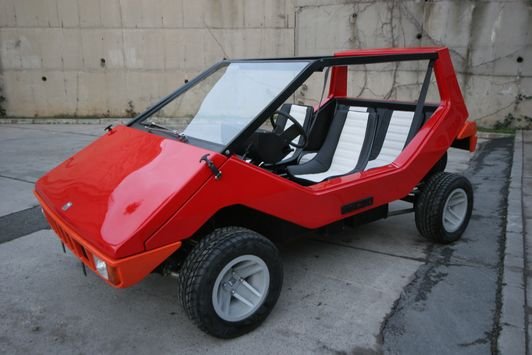In the sun-baked landscape of 1970s Turkey, a unique vehicle emerged from the ambitious workshops of the country’s first mass-production automotive manufacturer. The Anadol Böcek wasn’t just another car — it represented Turkey’s bold step into specialized vehicle manufacturing, combining military utility with civilian appeal in a package that would become legendary among automotive enthusiasts.
The story of the Böcek (“Bug” in Turkish) reflects a pivotal moment in automotive history when emerging markets began challenging established manufacturers. This distinctive dune buggy, produced from 1975 to 1977, showcases how innovative thinking and practical engineering can create something truly special, even with limited resources.
The Birth of a Turkish Legend
Turkey’s automotive journey took an unexpected turn when its military requested a light, agile vehicle capable of handling diverse terrain. Anadol, already established as the country’s pioneering car manufacturer, saw an opportunity to create something extraordinary. The company’s response would become more than just a military vehicle — it would emerge as a symbol of Turkish industrial capability.
Development began in earnest during a period of significant economic challenges. The global oil crisis had rattled automotive markets worldwide, yet Anadol pressed forward with characteristic determination. The program’s lead engineer, working with a small but dedicated team, focused on creating a vehicle that could excel in both military and civilian roles.
“The Böcek represented everything we believed possible in Turkish automotive engineering — lightweight construction, robust performance, and distinctive design. It was ahead of its time in many ways,” recalls Mehmet Yılmaz, one of the original development team members.
The vehicle’s development phase revealed both the strengths and limitations of Turkey’s emerging automotive sector. While some components needed to be sourced internationally, the overall design and assembly showcased domestic engineering talent. The project team worked to balance cost constraints with performance requirements, ultimately creating a vehicle that would stand out in automotive history.
Historical Reference!
The Anadol Böcek project marked the first time a Turkish manufacturer had independently developed a specialized military vehicle that also appealed to civilian markets. This dual-purpose approach would later influence other emerging market manufacturers.
Engineering Marvel in Fiberglass
The Böcek’s technical specifications tell a story of innovative engineering solutions. At its heart beats a Ford-sourced 1298cc engine, delivering 60 horsepower — modest by today’s standards but well-suited to the vehicle’s lightweight construction. The four-speed manual transmission provided reliable power delivery while maintaining mechanical simplicity.
Perhaps the most forward-thinking aspect of the Böcek was its fiberglass body construction. This choice wasn’t merely about weight savings; it represented a sophisticated approach to manufacturing in a developing industrial context. The fiberglass construction offered several key advantages:
- superior resistance to corrosion and environmental damage;
- reduced tooling costs compared to traditional steel stamping;
- ability to create complex shapes more easily;
- simplified repairs and maintenance procedures;
- enhanced overall durability in harsh conditions.
“Working with the fiberglass body was revolutionary for Turkish automotive manufacturing,” states Ali Kaya, a vintage car restoration specialist. “It allowed for a level of design freedom that would have been prohibitively expensive with traditional materials.”
The vehicle’s lightweight construction and robust chassis design created a highly capable off-road performer. Despite its compact dimensions, the Böcek offered impressive ground clearance and approach angles that made it especially suitable for rough terrain.
Design Philosophy and Innovation
The Böcek’s distinctive appearance reveals a fascinating blend of functional requirements and aesthetic ambition. While its basic shape might recall contemporary dune buggies like the Volkswagen-based Meyers Manx, the Böcek established its own design language that reflected its unique heritage and purpose.
The vehicle’s proportions and stance communicate its dual-nature capability. High ground clearance and prominent wheel arches suggest off-road prowess, while the streamlined profile and integrated roll cage demonstrate attention to aerodynamics and safety. The design team achieved a remarkable balance between military utility and civilian appeal.
Fact!
The Böcek's design influenced several subsequent Turkish military vehicle projects, establishing principles for combining rugged utility with manufacturing efficiency that remain relevant today.
Open-top architecture provided excellent visibility and ease of ingress/egress, crucial for both military and recreational use. The interior layout prioritized functionality while maintaining comfort, featuring easily readable instruments and durable materials throughout.
The designer’s attention to detail extended to practical considerations like maintenance access and parts commonality. This pragmatic approach to design would influence Turkish automotive development for years to come.
Legacy and Collector Status
Today, the Anadol Böcek occupies a unique position in automotive history. With only a limited production run during its brief manufacturing period, surviving examples have become highly sought after by collectors and museums. Each preserved vehicle tells a story of Turkish industrial ambition and engineering innovation.
Recent years have seen increased interest in the Böcek among automotive historians and collectors. Several comprehensive restorations have brought attention to the vehicle’s unique design features and historical significance. The growing appreciation for alternative automotive histories has placed the Böcek in a new light.
“Finding an original Böcek is like discovering a piece of automotive archaeology,” explains James Chen, international classic car collector. “Each example reveals something about the evolution of specialized vehicle design and manufacture.”
The Böcek’s influence extends beyond its limited production numbers. Its development program established important precedents for Turkish automotive engineering and demonstrated the potential for innovative design in emerging markets.
A Legacy That Endures
Looking back at the Anadol Böcek reveals more than just an interesting vehicle — it represents a moment when determination and creativity overcame significant industrial and economic challenges. The project’s ambitious scope and innovative solutions continue to inspire automotive engineers and designers.
In today’s context of emerging electric vehicle manufacturers and specialized mobility solutions, the Böcek’s story offers valuable lessons about innovation under constraints. Its combination of practical engineering and distinctive design demonstrates how meaningful automotive development can emerge from unexpected sources.
Pros & Cons
| Advantages | Disadvantages |
|---|---|
| Innovative fiberglass construction providing durability and corrosion resistance | Limited production run affecting parts availability |
| Versatile design suitable for both military and civilian use | Modest power output by modern standards |
| Lightweight construction enabling excellent maneuverability | Basic interior amenities compared to contemporary vehicles |
| Low maintenance requirements due to simple mechanical design | Limited weather protection due to open-top design |
| Historical significance as a pioneering Turkish vehicle | Challenging to find original examples in good condition |
| Excellent off-road capabilities for its era | Limited passenger capacity |
| Strong collector value due to rarity | Sparse dealer network during original production |
The Anadol Böcek stands as a testament to the power of focused engineering and design in creating specialized vehicles. While its production numbers were limited, its impact on Turkish automotive development and its status as a collectible military-civilian hybrid vehicle ensure its place in automotive history. For collectors and enthusiasts, the Böcek represents a unique combination of historical significance, innovative engineering, and distinctive design that continues to captivate automotive enthusiasts worldwide.

